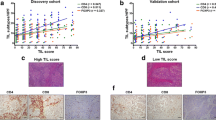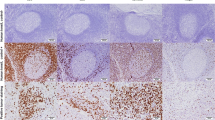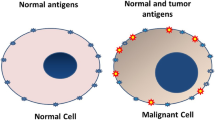Abstract
Desmoid tumors (DTs) are local aggressive neoplasms, whose therapeutic approach has remained so far unsolved and in many instances controversial. Nowadays, immunotherapy appears to play a leading role in the treatment of various tumor types. Characterization of the tumor immune microenvironment (TME) and immune checkpoints can possibly help identify new immunotherapeutic targets for DTs. We performed immunohistochemistry (IHC) on 33 formalin-fixed paraffin-embedded (FFPE) tissue sections from DT samples to characterize the TME and the immune checkpoint expression profile. We stained for CD3, CD4, CD8, CD20, FoxP3, CD45RO, CD56, CD68, NKp46, granzyme B, CD27, CD70, PD1 and PD-L1. We investigated the expression of the markers in the tumoral stroma, as well as at the periphery of the tumor. We found that most of the tumors showed organization of lymphocytes into lymphoid aggregates at the periphery of the tumor, strongly resembling tertiary lymphoid organs (TLOs). The tumor expressed a significant number of memory T cells, both at the periphery and in the tumoral stroma. In the lymphoid aggregates, we also recognized a significant proportion of regulatory T cells. The immune checkpoint ligand PD-L1 was negative on the tumor cells in almost all samples. On the other hand, PD1 was partially expressed in lymphocytes at the periphery of the tumor. To conclude, we are the first to show that DTs display a strong immune infiltration at the tumor margins, with formation of lymphoid aggregates. Moreover, we demonstrated that there is no PD-L1-driven immune suppression present in the tumor cells.



Similar content being viewed by others
Abbreviations
- CTLA-4:
-
Cytotoxic T lymphocyte antigen-4
- DT:
-
Desmoid tumors
- FAP:
-
Familial adenomatous polyposis
- FFPE:
-
Formalin-fixed paraffin embedded
- HEV:
-
High endothelial venules
- HRMA:
-
High-resolution melting analysis
- IHC:
-
Immunohistochemistry
- LN:
-
Lymph node
- NGS:
-
Next-generation sequencing
- PD(L)-1:
-
Programmed death (ligand)-1
- RTU:
-
Ready-to-use
- Treg:
-
Regulatory T cells
- TLO:
-
Tertiary lymphoid organs
- TME:
-
Tumor microenvironment
References
Rizvi NA, Mazieres J, Planchard D et al (2015) Activity and safety of nivolumab, an anti-PD-1 immune checkpoint inhibitor, for patients with advanced, refractory squamous non-small-cell lung cancer (CheckMate 063): a phase 2, single-arm trial. Lancet Oncol 16:257–265. https://doi.org/10.1016/S1470-2045(15)70054-9
Escobar C, Munker R, Thomas JO, Li BD, Burton GV (2012) Update on desmoid tumors. Ann Oncol 23:562–569. https://doi.org/10.1093/annonc/mdr386
Lazar AJ, Tuvin D, Hajibashi S et al (2008) Specific mutations in the beta-catenin gene (CTNNB1) correlate with local recurrence in sporadic desmoid tumors. Am J Pathol 173:1518–1527. https://doi.org/10.2353/ajpath.2008.080475
Gurbuz AK, Giardiello FM, Petersen GM, Krush AJ, Offerhaus GJ, Booker SV, Kerr MC, Hamilton SR (1994) Desmoid tumours in familial adenomatous polyposis. Gut 35:377–381
Calvert GT, Monument MJ, Burt RW, Jones KB, Randall RL (2012) Extra-abdominal desmoid tumors associated with familial adenomatous polyposis. Sarcoma 2012:726537. https://doi.org/10.1155/2012/726537
Carlson JW, Fletcher CD (2007) Immunohistochemistry for beta-catenin in the differential diagnosis of spindle cell lesions: analysis of a series and review of the literature. Histopathology 51:509–514. https://doi.org/10.1111/j.1365-2559.2007.02794.x
Kasper B, Strobel P, Hohenberger P (2011) Desmoid tumors: clinical features and treatment options for advanced disease. Oncologist 16:682–693. https://doi.org/10.1634/theoncologist.2010-0281
Kasper B, Baumgarten C, Bonvalot S et al (2015) Management of sporadic desmoid-type fibromatosis: a European consensus approach based on patients’ and professionals’ expertise—a sarcoma patients EuroNet and European organisation for research and treatment of cancer/soft tissue and bone sarcoma group initiative. Eur J Cancer 51:127–136. https://doi.org/10.1016/j.ejca.2014.11.005
Mahoney KM, Rennert PD, Freeman GJ (2015) Combination cancer immunotherapy and new immunomodulatory targets. Nat Rev Drug Discov 14:561–584. https://doi.org/10.1038/nrd4591
Sharma P, Allison JP (2015) The future of immune checkpoint therapy. Science 348:56–61. https://doi.org/10.1126/science.aaa8172
Burgess M, Tawbi H (2015) Immunotherapeutic approaches to sarcoma. Curr Treat Options Oncol 16:26. https://doi.org/10.1007/s11864-015-0345-5
Jacobs J, Zwaenepoel K, Rolfo C et al (2015) Unlocking the potential of CD70 as a novel immunotherapeutic target for non-small cell lung cancer. Oncotarget 6:13462–13475. https://doi.org/10.18632/oncotarget.3880
Marcq E, Siozopoulou V, De Waele J et al (2017) Prognostic and predictive aspects of the tumor immune microenvironment and immune checkpoints in malignant pleural mesothelioma. Oncoimmunology 6:e1261241. https://doi.org/10.1080/2162402X.2016.1261241
Ager A (2017) High endothelial venules and other blood vessels: critical regulators of lymphoid organ development and function. Front Immunol 8:45. https://doi.org/10.3389/fimmu.2017.00045
Martinet L, Le Guellec S, Filleron T, Lamant L, Meyer N, Rochaix P, Garrido I, Girard JP (2012) High endothelial venules (HEVs) in human melanoma lesions: major gateways for tumor-infiltrating lymphocytes. Oncoimmunology 1:829–839. https://doi.org/10.4161/onci.20492
Martinet L, Garrido I, Filleron T, Le Guellec S, Bellard E, Fournie JJ, Rochaix P, Girard JP (2011) Human solid tumors contain high endothelial venules: association with T- and B-lymphocyte infiltration and favorable prognosis in breast cancer. Cancer Res 71:5678–5687. https://doi.org/10.1158/0008-5472.CAN-11-0431
Jones GW, Hill DG, Jones SA (2016) Understanding immune cells in tertiary lymphoid organ development: it is all starting to come together. Front Immunol 7:401. https://doi.org/10.3389/fimmu.2016.00401
Jing F, Choi EY (2016) Potential of cells and cytokines/chemokines to regulate tertiary lymphoid structures in human diseases. Immune Netw 16:271–280. https://doi.org/10.4110/in.2016.16.5.271
Dieu-Nosjean MC, Antoine M, Danel C et al (2008) Long-term survival for patients with non-small-cell lung cancer with intratumoral lymphoid structures. J Clin Oncol 26:4410–4417. https://doi.org/10.1200/JCO.2007.15.0284
Pages F, Galon J, Dieu-Nosjean MC, Tartour E, Sautes-Fridman C, Fridman WH (2010) Immune infiltration in human tumors: a prognostic factor that should not be ignored. Oncogene 29:1093–1102. https://doi.org/10.1038/onc.2009.416
Hori S, Nomura T, Sakaguchi S (2003) Control of regulatory T cell development by the transcription factor Foxp3. Science 299:1057–1061. https://doi.org/10.1126/science.1079490
Hinz S, Pagerols-Raluy L, Oberg HH et al (2007) Foxp3 expression in pancreatic carcinoma cells as a novel mechanism of immune evasion in cancer. Cancer Res 67:8344–8350. https://doi.org/10.1158/0008-5472.CAN-06-3304
Chanmee T, Ontong P, Konno K, Itano N (2014) Tumor-associated macrophages as major players in the tumor microenvironment. Cancers (Basel) 6:1670–1690. https://doi.org/10.3390/cancers6031670
Jinushi M, Komohara Y (2015) Tumor-associated macrophages as an emerging target against tumors: creating a new path from bench to bedside. Biochim Biophys Acta 1855:123–130. https://doi.org/10.1016/j.bbcan.2015.01.002
Curiel TJ, Coukos G, Zou L et al (2004) Specific recruitment of regulatory T cells in ovarian carcinoma fosters immune privilege and predicts reduced survival. Nat Med 10:942–949. https://doi.org/10.1038/nm1093
Mizukami Y, Kono K, Kawaguchi Y, Akaike H, Kamimura K, Sugai H, Fujii H (2008) CCL17 and CCL22 chemokines within tumor microenvironment are related to accumulation of Foxp3 + regulatory T cells in gastric cancer. Int J Cancer 122:2286–2293. https://doi.org/10.1002/ijc.23392
Matter M, Mumprecht S, Pinschewer DD, Pavelic V, Yagita H, Krautwald S, Borst J, Ochsenbein AF (2005) Virus-induced polyclonal B cell activation improves protective CTL memory via retained CD27 expression on memory CTL. Eur J Immunol 35:3229–3239. https://doi.org/10.1002/eji.200535179
Claus C, Riether C, Schurch C, Matter MS, Hilmenyuk T, Ochsenbein AF (2012) CD27 signaling increases the frequency of regulatory T cells and promotes tumor growth. Cancer Res 72:3664–3676. https://doi.org/10.1158/0008-5472.CAN-11-2791
Matter MS, Claus C, Ochsenbein AF (2008) CD4 + T cell help improves CD8 + T cell memory by retained CD27 expression. Eur J Immunol 38:1847–1856. https://doi.org/10.1002/eji.200737824
Jiang Y, Li Y, Zhu B (2015) T-cell exhaustion in the tumor microenvironment. Cell Death Dis 6:e1792. https://doi.org/10.1038/cddis.2015.162
Ruprecht CR, Gattorno M, Ferlito F, Gregorio A, Martini A, Lanzavecchia A, Sallusto F (2005) Coexpression of CD25 and CD27 identifies FoxP3 + regulatory T cells in inflamed synovia. J Exp Med 201:1793–1803. https://doi.org/10.1084/jem.20050085
Duggleby RC, Shaw TN, Jarvis LB, Kaur G, Gaston JS (2007) CD27 expression discriminates between regulatory and non-regulatory cells after expansion of human peripheral blood CD4 + CD25 + cells. Immunology 121:129–139. https://doi.org/10.1111/j.1365-2567.2006.02550.x
Mlecnik B, Tosolini M, Kirilovsky A et al (2011) Histopathologic-based prognostic factors of colorectal cancers are associated with the state of the local immune reaction. J Clin Oncol 29:610–618. https://doi.org/10.1200/JCO.2010.30.5425
Hadrup S, Donia M, Thor Straten P (2013) Effector CD4 and CD8 T cells and their role in the tumor microenvironment. Cancer Microenviron 6:123–133. https://doi.org/10.1007/s12307-012-0127-6
Galon J, Costes A, Sanchez-Cabo F et al (2006) Type, density, and location of immune cells within human colorectal tumors predict clinical outcome. Science 313:1960–1964. https://doi.org/10.1126/science.1129139
Galon J, Pages F, Marincola FM, Thurin M, Trinchieri G, Fox BA, Gajewski TF, Ascierto PA (2012) The immune score as a new possible approach for the classification of cancer. J Transl Med 10:1. https://doi.org/10.1186/1479-5876-10-1
Fridman WH, Pages F, Sautes-Fridman C, Galon J (2012) The immune contexture in human tumours: impact on clinical outcome. Nat Rev Cancer 12:298–306. https://doi.org/10.1038/nrc3245
Giraldo NA, Becht E, Pages F et al (2015) Orchestration and prognostic significance of immune checkpoints in the microenvironment of primary and metastatic renal cell cancer. Clin Cancer Res 21:3031–3040. https://doi.org/10.1158/1078-0432.CCR-14-2926
Appay V, van Lier RA, Sallusto F, Roederer M (2008) Phenotype and function of human T lymphocyte subsets: consensus and issues. Cytometry A 73:975–983. https://doi.org/10.1002/cyto.a.20643
Donnem T, Hald SM, Paulsen EE et al (2015) Stromal CD8 + T-cell density-A promising supplement to TNM staging in non-small cell lung cancer. Clin Cancer Res 21:2635–2643. https://doi.org/10.1158/1078-0432.CCR-14-1905
Mandelboim O, Porgador A (2001) NKp46. Int J Biochem Cell Biol 33:1147–1150
Prendergast GC, Jaffee EM (2013) Cancer immunotherapy: immune suppression and tumor growth, 2nd edition. Elsevier/AP, Academic Press is an imprint of Elsevier, Amsterdam; Boston
Riazi Rad F, Ajdary S, Omranipour R, Alimohammadian MH, Hassan ZM (2015) Comparative analysis of CD4 + and CD8 + T cells in tumor tissues, lymph nodes and the peripheral blood from patients with breast cancer. Iran Biomed J 19:35–44
Chen DS, Mellman I (2013) Oncology meets immunology: the cancer-immunity cycle. Immunity 39:1–10. https://doi.org/10.1016/j.immuni.2013.07.012
Lee J, Ahn E, Kissick HT, Ahmed R (2015) Reinvigorating exhausted T cells by blockade of the PD-1 pathway. For Immunopathol Dis Therap 6:7–17. https://doi.org/10.1615/ForumImmunDisTher.2015014188
Acknowledgements
The majority of human biological material used in this publication was provided by the Tumor bank, Antwerp University Hospital, Belgium, which is funded by the National Cancer Plan.
Funding
The authors received no specific funding for this work.
Author information
Authors and Affiliations
Contributions
VS, EM and JJ designed the study and performed the data acquisition and analysis. CH processed the slides. KZ and SP performed the immunohistochemical staining. CH provided patient material. All authors contributed to the interpretation of the data, sample collection, drafting and revision of the manuscript.
Corresponding author
Ethics declarations
Conflict of interest
All authors declare that they have no conflicts of interest.
Ethical approval and ethical standards
We received approval by the Ethics Committee of the Antwerp University Hospital/University of Antwerp (EC 18/45/517) to use historical samples. As it was a retrospective study, no informed consent of the patients could be obtained.
Additional information
Publisher's Note
Springer Nature remains neutral with regard to jurisdictional claims in published maps and institutional affiliations.
Electronic supplementary material
Below is the link to the electronic supplementary material.
Rights and permissions
About this article
Cite this article
Siozopoulou, V., Marcq, E., Jacobs, J. et al. Desmoid tumors display a strong immune infiltration at the tumor margins and no PD-L1-driven immune suppression. Cancer Immunol Immunother 68, 1573–1583 (2019). https://doi.org/10.1007/s00262-019-02390-0
Received:
Accepted:
Published:
Issue Date:
DOI: https://doi.org/10.1007/s00262-019-02390-0




